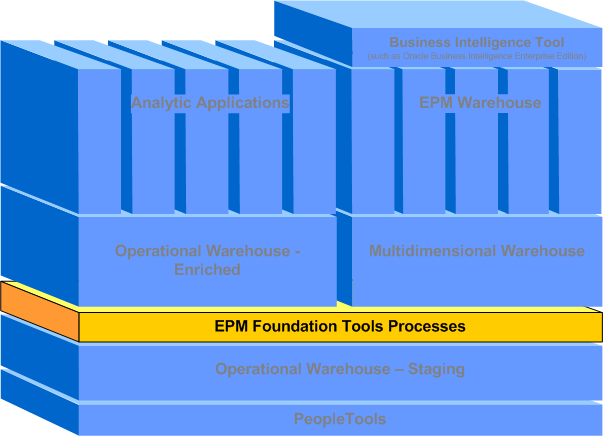EPM Foundation Toolset
EPM is delivered with EPM Foundation tools. These set of tools enable you to enrich, audit, and manage the rich content included with EPM with a high degree of automation. For example, the Clone Metadata tool enables you to quickly and easily create a duplicate copy of your existing metadata. EPM Foundation tools can be used with content included in the Operational Warehouse and the Multidimensional Warehouse.
Image: EPM Foundation
The following graphic illustrates how the EPM foundation tools and processes fit into the overall EPM architecture.

The following sections provide additional details about EPM Foundation tools.
Setup Tools
Implementing EPM requires that you specify parameters within the warehouse that reflect your organization's basic business processes and parameters. For example, you must define parameters for unit of measure, country, and accounting calenders in EPM .
EPM delivers several setup tools which enable you to quickly and easily setup basic information in the warehouse including unit of measure, multiple language and currency, and operator defaults.
Security Tools
EPM security enables you to set up data access at a variety of entry points and control access to meet your business needs, right down to an individual field. Security tools enable you to:
Use application security to control access to applications, menus, and objects. You can specify which applications are available to a group of users, which menus and EPM objects they can access.
Use row-level security, for example, to implement dimension-level access to particular products, customers, or key performance metrics. This ensures that highly sensitive data is protected.
You can also set up a specific security for the IBM WebSphere ETL tool, see Understanding EPM Security and Setups
Data Storage and Classification Tools
Implementing EPM involves configuring the system's structures to how your business operates. You can share common tables across reporting and analytical applications to minimize redundant data and system maintenance tasks.
Record metadata, for example, defines the first level of EPM metadata. It is used to identify and classify the tables that constitute the EPM data model. The record metadata identifies EPM tables as fact tables, fact reference tables, dimension tables, dimension reference tables, or transaction-dated tables. Each table is also classified to a specific data layer: the OWE or the MDW.
Tree manager provides an intuitive way to create, view, and maintain hierarchical definitions. An easy to understand user interface facilitates the creation and maintenance of trees. Tree mover enables you to moved PeopleSoft trees between different PeopleSoft application databases.
See Understanding PeopleSoft EPM Business Rule Setups, and Understanding Metadata,
Performance Management Related Tools
EPM utilizes shared components that provide functionality key to supporting high-volume analytical applications:
Reusable filters and constraints stored in the metadata enable you to define sets of rules that can be shared across applications.
Jobstreams streamline analytic processes and enable applications to run concurrently.